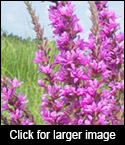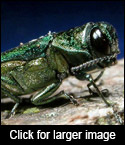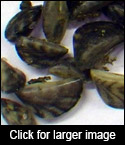Invasive Species
 |
 |
 |
 |
What are Non-Native Invasive Species (NNIS)
NNIS are defined as “any introduced species that can or may potentially cause economic or environmental harm or harm to human health” and include terrestrial and aquatic species; which can be plants, animals or pathogens. Non-native species have been introduced into the United States through a variety of pathways.
 Approximately 50,000 non-native species have been introduced into the United States. There are many species introduced in the United States but only a small portion ever escape. Of the non-native species that escape, an even smaller portion becomes invasive. There are currently 112 plant species that are categorized as noxious weeds by the federal government. NNIS have characteristics that allow them to successfully adapt in new habitats. It is difficult to know in advance which species have the potential to become a nuisance.
Approximately 50,000 non-native species have been introduced into the United States. There are many species introduced in the United States but only a small portion ever escape. Of the non-native species that escape, an even smaller portion becomes invasive. There are currently 112 plant species that are categorized as noxious weeds by the federal government. NNIS have characteristics that allow them to successfully adapt in new habitats. It is difficult to know in advance which species have the potential to become a nuisance.
Although there are many different types of NNIS, there are certain characteristics that all these species have in common. Invasive species are opportunists and will readily invade any ecosystem that suits their needs. The majority of these species originate from far away locations that result in a lack of native predators and disease to reduce the population to manageable amounts. An NNIS may also come from a different region within the United States. This allows invasive species the ability to outcompete native species that have natural mechanisms to keep their numbers in check. NNIS can often tolerate a wide range of environmental conditions and this enables them to survive in many habitats. Areas of disturbance leave a niche that invasive species will readily utilize. A majority of invasive species have a high rate of reproduction including plant species which are known to be prominent seed producers. Some invasive plant species can also grow late into the fall that enables them to out compete native vegetation.
How Do Non-Native Invasive Species Spread?
 The mechanisms for movement, known as pathways, are typically assisted by human activities that may be either intentional or unintentional. Examples of intentional introduction include Burmese Python and European Starling. The Burmese Python has been known to be released by pet owners once it becomes too large or expensive to be kept. The European Starling was introduced by the American Acclimatization Society that wanted to introduce all the bird species mentioned in William Shakespeare works to North America. The unintentional introduction of NNIS can also accrue when they are living in or attached to items that are brought from a different region. The Emerald Ash Borer (EAB) was hypothesized to have been introduced to Michigan by the transport of pallets or crates made of ash that was infested with EAB. The majorities of introductions are the result of cultivation escapes, whether horticultural or pets. The agency charged with regulating the movement of plants and animals into the country is the United States Department of Agriculture (USDA), Animal and Plant Health Inspection Service (APHIS), but it is a daunting task to prevent all introductions of NNIS.
The mechanisms for movement, known as pathways, are typically assisted by human activities that may be either intentional or unintentional. Examples of intentional introduction include Burmese Python and European Starling. The Burmese Python has been known to be released by pet owners once it becomes too large or expensive to be kept. The European Starling was introduced by the American Acclimatization Society that wanted to introduce all the bird species mentioned in William Shakespeare works to North America. The unintentional introduction of NNIS can also accrue when they are living in or attached to items that are brought from a different region. The Emerald Ash Borer (EAB) was hypothesized to have been introduced to Michigan by the transport of pallets or crates made of ash that was infested with EAB. The majorities of introductions are the result of cultivation escapes, whether horticultural or pets. The agency charged with regulating the movement of plants and animals into the country is the United States Department of Agriculture (USDA), Animal and Plant Health Inspection Service (APHIS), but it is a daunting task to prevent all introductions of NNIS.
Once NNIS are in the US they can be transported to new locations by many pathways. For invasive plant species, wind propels seeds short distances but human activities are capable of carrying seeds much longer distances. Firewood is a popular pathway for an NNIS to be spread into another region. Regardless of whether introduction is intentional or unintentional, the release of an NNIS can lead to unintended results.
What Are the Threats of Non-Native Invasive Species?
Invasive Species cost the US billions of dollars every year; the cost is an accumulation of direct and indirect costs. The direct costs include loss of crop production due to competition with NNIS, and control and eradication costs. A specific management goal for any terrestrial NNIS depends on the characteristics of the species and whether or not it can be eliminated or controlled in the region.
Aquatic invasive species management includes prevention and quarantine. Public education and outreach are utilized to help prevent further spread of invasive species. There are numerous programs and agencies involved in fighting invasive species in Minnesota. Help Stop Aquatic Hitchhikers and the Burn It Where You Buy It are two invasive species programs promoted by the Minnesota Department of Natural Resources that aim to educate the public about the potential risks of NNIS introductions.
 The indirect costs that NNIS have affects both to the environment and human health. NNIS affect the ecosystem by outcompeting native species for space and energy. They can severely affect the diversity of an ecosystem including high quality forest ecosystems by replacing crucial species in a niche with ones that offer little to no benefits. The decline of some endangered, threatened, and sensitive species is at least partially the result of NNIS. In addition, invasive plant species have been known to destabilize habitat that can result in soil erosion and degradation of wildlife habitat. Human health can also be negatively affected by NNIS due to allergic reactions, diseases, and injury that results from contact. NNIS are also known to damage to infrastructure. For example, Zebra mussels can attach and clog water intake pipes.
The indirect costs that NNIS have affects both to the environment and human health. NNIS affect the ecosystem by outcompeting native species for space and energy. They can severely affect the diversity of an ecosystem including high quality forest ecosystems by replacing crucial species in a niche with ones that offer little to no benefits. The decline of some endangered, threatened, and sensitive species is at least partially the result of NNIS. In addition, invasive plant species have been known to destabilize habitat that can result in soil erosion and degradation of wildlife habitat. Human health can also be negatively affected by NNIS due to allergic reactions, diseases, and injury that results from contact. NNIS are also known to damage to infrastructure. For example, Zebra mussels can attach and clog water intake pipes.
What Laws and Regulations Are in Place to Protect Against Non-Native Invasive Species?
In 1999, executive order 13112 was signed by President Bill Clinton, which defined invasive species, established the Invasive Species Advisory Council and required federal agencies to be accountable for funding, authorizing or carrying out actions that prevent the spread and control of NNIS. The Invasive Species Council addresses issues categorized as prevention, early detection and rapid response, control and management, research and information management, communication, education and outreach, and organizational collaboration. Minnesota Invasive Species Advisory Council (MISAC), established in 2001, works with member organizations to promote and implement the Minnesota’s Statewide Invasive Species Management Plan. Below is a list of agencies that regulate invasive species in Minnesota and the laws and regulations in Minnesota. Leech Lake Band of Ojibwe has rights over all natural resources on the reservation and has a conservation code for invasive species.
Regulating Agencies in Minnesota
Minnesota Department of Natural Resources (MN DNR)
Minnesota Department of Agriculture (MDA)
Minnesota Pollution Control Agency (MPCA)
Tribal Natural Resource Management Agencies
U.S. Department of Agriculture, Animal and Plant Health Inspection Service (USDA, APHIS)
U.S. Fish and Wildlife Services (USFWS)
U.S. Coast Guard
U.S. Environmental Protection Agency (U.S. EPA)
Aquatic and Wild Animal Invasive Species Law Classification Aquatic Invasive Species Law Terrestrial Invasive Species Law |
Which Non-Native Invasive Species Are of Concern on Leech Lake Reservation?
Leech Lake Reservation is comprised of numerous lakes, streams, wetlands, upland hardwood and conifer forests as well as lowland conifer swamps. These habitats provide an opportunity for traditional gathering of medicinal plants, nuts, berries and fruits as well as fishing and hunting. Invasive species are a serious threat to habitats and traditional hunting and gathering on the Leech Lake Reservation.
The DRM plant department uses integrated weed management practices to addresses the needs of the Leech Lake Band of Ojibwe for the various invasive species throughout Leech Lake Reservation. Our focus is on terrestrial NNIS plant species because of the threats these pose to many natural resources and because there are other agencies that work to control aquatic invasive species. The integrated weed management principle utilizes methods of control in a timed manner to have the greatest impact on NNIS.
The invasive species are categorized based on the threats they pose to the natural resources on the reservation. The list is separated into terrestrial invasive species and aquatic invasive species. To learn more about a specific invasive species, click on the picture. The pictures are linked to additional information about the species. Species listed as potential threats are also listed because of the ability to exist on Leech Lake Reservation, although they are currently not found.
What Can People Do to Fight Non-Native Invasive Species?
There are numerous things a person can do to ensure that they do not spread NNIS and you will find some simple practices outlined below.
- Learn how to identify the various invasive species that are located on Leech Lake Reservation. Recognition is the first step in managing invasive species.
- Controlling weeds on your own property helps to reduce the spread of the populations.
- Buy firewood from local location where it is to be burned is another way to potentially reduce the spread of invasive species.
- Ensure that feed for livestock is free of weeds.
- Choose plants for your garden that are native to the area, or use ones that have do not spread.
- Drain and clean material from your boat or other equipment before leaving a lake access.
Links to Resources
Minnesota DNR. (2014). Invasive Species in Minnesota. http://www.dnr.state.mn.us/invasives/index.html
Contact Us
DRM (218) 335-7400
| Name | Title | Phone |
| Mortensen, Steve | Fish, Wildlife & Plant Resources Program Director | 335-7421 |
| Katie Zlonis | Botanist/Invasive Species Program Manager | 335-7442 |
| Finn, Jon | Fish & Wildlife Field Specialist | 335-7424 |
| White, Gary | Assistant Hatchery Manager | 335-7424 |
| Robinson, Martin | Fish and Wildlife Technician | 335-7424 |















 Division of Resource Management
Division of Resource Management